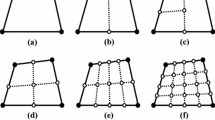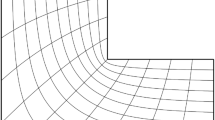We propose a finite-element approach with the use of Hermitian splines for reducing the problem of plotting of stress trajectories for finding two potential functions that satisfy conditions of interpolation of first derivatives at nodes of a regular mesh. The efficiency of this approach is demonstrated on test problems, and features of computational relations are determined.
Similar content being viewed by others
References
A. George and J. W.-H. Liu, Computer Solutions of Large Sparse Positive Definite Systems, Prentice-Hall, Englewood Cliffs (1981).
O. C. Zienkiewicz, The Finite-Element Method in Engineering Science, McGraw-Hill, London–New York (1975).
F. Pinezhaninov, Base Functions for Finite Elements with Derivatives [in Russian], (2000), http://pinega.da.ru.
P. G. Ciarlet, The Finite-Element Method for Elliptic Problems, North-Holland, Amsterdam (1978).
S. P. Timoshenko and J. N. Goodier, Theory of Elasticity, McGraw-Hill, New York (1970).
A. E. Scheidegger, Principles of Geodynamics, Springer, Berlin (1982).
A. N. Galybin, “Introduction of the stress trajectories element method for stress analysis in tectonic plates,” Geophys. Res. Abstr., Vol. 9, 08179. SRef-ID: 1607-7962/gra/EGU2007-A-08179, European Geosciences Union (2007).
M. Jo, M. Taguchi, and H. Suzuki, “Automatic plotting of principal stress trajectories by direction function contouring,” Trans. Jpn. Soc. Mech. Eng. A, 68, No. 667, 385–390 (2002).
G. Petrucci and G. Restivo, “Automated stress separation along stress trajectories,” Exp. Mech., 47, No. 6, 733–743 (2007).
J. G. Ramsay and R. G. Lisle, “The techniques of modern structural geology,” in: Applications of Continuum Mechanics in Structural Geology, Vol. 3, Elsevier (2000), pp. 701–1061.
F. Thamm, “The role of the stress trajectories as an aid in the choice of the suitable shape of load-bearing structural element of engines and structure,” Period. Polytechn., Ser. Mech. Eng., 44, No. 1, 171–183 (2000).
J. Weertman, “Stress trajectories for mode I and mode II cracks,” Int. J. Fract., 137, No. 1, 251–259 (2006).
Author information
Authors and Affiliations
Rights and permissions
About this article
Cite this article
Marchuk, M.V., Khomyak, M.M. Hermitian splines as basis functions of the finite-element method for plotting stress trajectories. J Math Sci 168, 673–687 (2010). https://doi.org/10.1007/s10958-010-0018-7
Received:
Published:
Issue Date:
DOI: https://doi.org/10.1007/s10958-010-0018-7




